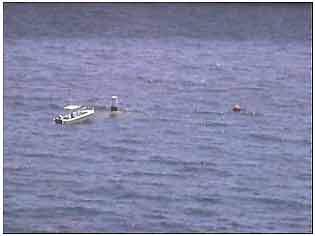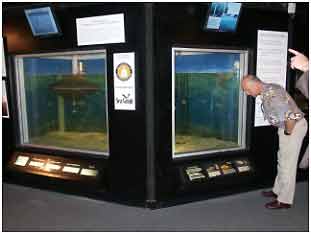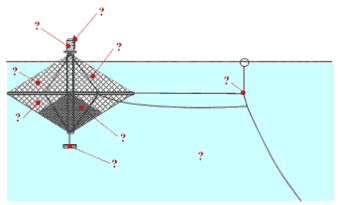February 2004 // Volume 42 // Number 1 // Tools of the Trade // 1TOT2
Innovative Tools in Public Education and Technology Transfer for an Emerging Offshore Aquaculture Industry
Abstract
Although principally the same as other aquaculture operations,
the details involved in raising fish in cages several miles offshore in the
Gulf of Mexico can be hard to imagine--for both the general public and aquaculture
practitioners. The Offshore Aquaculture Consortium (OAC) turned to technology
innovation and to industry and university partnerships as "Extension
tools" to educate these stakeholder groups. The OAC established Cage
Cam to provide real-time Internet feeds of the offshore operations, an aquarium
exhibit for conceptualization, and a "How-to" feature on our Web
site for logistics transfer.
Introduction
Many times researchers and Extension personnel deal with projects that are difficult to "put your arms around." This poses a unique challenge when you're tasked with disseminating project information to the general public and providing technology transfer to interested industry personnel. The Offshore Aquaculture Consortium used new innovative communication tools to take their stakeholders 26 miles offshore in the Gulf of Mexico.
The Offshore Aquaculture Consortium (OAC) was formed to conduct the necessary research for development of an offshore aquaculture industry in the Gulf of Mexico region (Bridger et al., 2001). Although principally the same as other aquaculture operations, the concept of raising popular recreational and important commercial fish species offshore in the Gulf of Mexico is a substantial departure from the existing visualization of catfish farming in the Mississippi Delta region. Public conceptualization of open ocean aquaculture is further complicated because of its remoteness and distance from shore.
OAC Extension efforts, therefore, have focused on bringing the remote, and somewhat abstract, operations of offshore aquaculture to the general public and future investors of this emerging industry. We set the following objectives to meet our Extension goal:
- Provide conceptualization of an offshore aquaculture enterprise to the general public.
- Develop exhibitory that explains the need for national aquaculture production and demonstrates offshore aquaculture operations in the Gulf of Mexico.
- Transfer the technology of logistics mitigation learned while operating an aquaculture enterprise in the U.S. Exclusive Economic Zone (EEZ).
Approach and Outcome
Cage Cam
The OAC research site is adjacent to a ChevronTexaco gas platform approximately 26 miles offshore in U.S. EEZ federal waters. This site was chosen because it provided sufficient depth that allowed the cage to be sunk in severe sea conditions and its location adjacent to a manned gas production platform provided passive protection from shipping activity in the area and cage surveillance.
ChevronTexaco's strong interest in the project, and the "bird's eye view" of the cage from the platform, led to new collaborative outreach efforts, including mounting a camera on the platform and transmitting streaming pictures of the cage via Internet to researchers and the general public. OAC researchers used their access to the camera controls to pan, zoom, and focus the camera to view the cage's actions in various sea conditions. The education and outreach merit of Cage Cam also provided real-time visualization of an operating cage site to the general public (Figure 1).
Figure 1.
Cage Cam Provides Real-Time Images of the Cage 26 Miles Offshore

Public Aquarium Exhibit
The University of Southern Mississippi operates the J.L. Scott Marine Education Center and Aquarium (MEC) in Biloxi, Mississippi. More than 80,000 visitors annually tour the MEC, including 31,000 students and teachers. OAC researchers approached MEC personnel with the idea of educating the public through an exhibit that explains:
- The expanding role of aquaculture in the United States,
- Why offshore aquaculture is needed to meet the country's increasing seafood demand, and
- How the OAC's research efforts in the Gulf of Mexico can help.
Discussions with the MEC educators resulted in a first-class exhibit that includes a 3,000-gallon aquarium with a scale model of the cage and several individual fish of the candidate offshore aquaculture species: cobia, red snapper, and red drum (Figure 2). MIT Researchers constructed a large-scale model of the cage, including its Robofeeder, shackles, ballast weight, and mooring system.
Figure 2.
OAC Exhibit at the JL Scott Marine Education Center & Aquarium

The display also includes two flat-screen monitors. One displays presentations such as the cage's deployment. The second displays real-time images from Cage Cam, illustrating to visitors that the aquarium's scale model replicates OAC's full-size cage in the Gulf.
Since its debut in April 2002, thousands have personally visited the exhibit, and an additional 240,000 students and teachers have visited through Mississippi Educational TV.
Technology Transfer
Owing to offshore's remoteness of operations and frequent harsh sea conditions, simple transfer of coastal or nearshore aquaculture logistic mitigation procedures to offshore aquaculture is unsuitable. Because the OAC project is developmental by nature and is expected to encounter numerous operational issues, a special OAC Web site was developed to disseminate lessons learned to other researchers and offshore aquaculture developers <http://www.masgc.org/oac>.
The site's "How-to" section provides viewers with a cage schematic featuring several hot links to various components of the OAC's cage system (Figure 3). Each linked page contains explanation and images describing that particular operation so that the viewer can perform the operation on his or her "own" offshore aquaculture operation.
Figure 3.
"How-to" Web Page on the OAC Internet Site

Conclusions
Faced with the challenge of educating the public and industry stakeholders about offshore aquaculture and the its research project sited 26 miles off Mississippi's coast, the OAC turned to technological innovation and collaboration with industry and public aquaria for help. Through its public education and technology transfer efforts, offshore aquaculture can now be understood and visualized more easily by the public, and researched and developed more efficiently by aquaculture enthusiasts.
Acknowledgments
The authors wish to thank ChevronTexaco for its continued support of OAC research and Extension efforts; Verizon for supplying the Internet bandwidth giving the public an opportunity to view Cage Cam online; John Grigsby, as designer of the OAC Web site; and the staff of the MEC for their assistance in the development, construction, and maintenance of the OAC exhibit. The OAC is funded through the National Sea Grant College Program of the U.S. Department of Commerce's National Oceanic and Atmospheric Administration (NOAA Grant #NA16RG1631), the Mississippi-Alabama Sea Grant Consortium and the University of Southern Mississippi.
References
Bridger, C. J., Costa-Pierce, B. A., Goudey, C. A., Stickney, R. R., K.M. Fletcher, J.R. Gold, D.H. Lewis, J. Lotz, B.C. Posadas, Neyrey, E. W., Rayburn, R., Reid, T., Moncreiff, C. A., & Swann, D. L. (2001). Sustainable offshore aquaculture development in the Gulf of Mexico. World Aquaculture. September 2001: 28-30, 32-33, 60.
